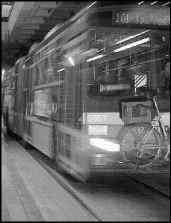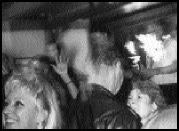WILL SOUND TRANSIT’S light rail make traffic worse or better downtown?
The debate raged on as light rail’s opponents and backers released dueling reports in the last two weeks. The focus of the latest dustup over rail is the bus tunnel that runs underneath downtown. Sound Transit needs to use the tunnel to get light rail through downtown, but light rail’s opponents believe the tunnel should be used solely for buses.
Last week, Sound Transit released a report showing that joint bus-rail operations in the tunnel, currently traversed by around 1,200 buses daily, could actually result in a net loss of buses on surface streets, as people opt to use light rail rather than hopping on Metro’s buses.
Come again? Didn’t a report issued by six light-rail opponents on the 13-member King County Council (which, since King County owns the tunnel, controls the tunnel’s ultimate fate) just reach the exact opposite conclusion?
As usual, it’s all in how you massage the numbers.
The Sound Transit report assumes, based on averages provided by King County Metro, that people don’t like to stand up on buses. According to the report, buses in the tunnel would only be 80 percent full, with just 46 riders on board. The same report also assumes that people do like to stand up on light rail; that translates into light-rail cars packed with 137 people, or 1.85 people for every available seat. That adds up to a peak capacity of about 16,480 trips through the tunnel every hour—more than enough to hold street-level bus traffic at or below current levels. Sound Transit project manager Michael Williams says the figures for light rail give each standing passenger more than five square feet of standing room; moreover, since light rail would presumably stop more frequently than express bus service, people would have more opportunities to scramble for seats. Contrast that with express buses, which don’t stop between downtown and their destinations. “If you’re taking a trip from the tunnel to Federal Way, you don’t want to be standing all the way there,” Williams says.
But critics say joint operations of rail and buses in the tunnel would be unsafe, uneconomical, and ultimately inefficient. In late July, a report commissioned by the King County Council’s transportation committee concluded that joint tunnel operations would cost more than bus-only use, greatly increase congestion on downtown streets, and result in much lower tunnel usage—11,000 passengers per hour, compared to 18,500 with buses only. Compared to the Sound Transit report, the county council’s study assumed a slightly more modest 533 passengers per train, slower headways between trains, and 90 passengers per bus—twice as many as in Sound Transit’s study.
The study’s sponsor and King County Council member Maggi Fimia says people are sick of waiting for light rail to materialize. Fimia notes that since 1999, when an agreement was negotiated among Sound Transit, the city of Seattle, and King County to transfer the tunnel from the county to the transit agency in 2004, Sound Transit has had to drastically revise its cost estimates—and the scheduled completion date—for its 24-mile light-rail line. Those changes meant the agreement had to be re-negotiated, giving Fimia and five others on the council an opportunity to propose that trains be blocked permanently from the tunnel as a condition of its transfer to the transit agency. “The [light-rail] program is vastly different, and the impacts to our system are much more dire than we had believed,” Fimia says. “At this point, we as a county need to protect our bus riders. We could put twice as many buses in there as we have now.”
Sound Transit supporters, including consultant Roger Pence, say the county’s consultants are cooking their numbers. “They’re assuming a level of bus activity that is on the ragged edge of practicality,” Pence says. “Then they compare that to light rail operating at a very modest level. It’s not apples to apples.” Pence says the study’s authors are all affiliated with Sane Transit, a group opposed to light rail. He claims they reached a foregone conclusion, given their published anti-light-rail leanings. “This is just a rehashing of preexisting political tracts on their Web page where they said essentially the same thing,” Pence says. “All [the consultants] did for $25,000 was regurgitate their previous writings.”
But Fimia says critics need to take a harder look at the numbers before they criticize the group’s proposals. “It’s very easy to say, ‘You have doubts and you’re a skeptic, therefore everything in your report is not valid.'” But, Fimia asks, “For those of us who were light-rail supporters, what in the world would be our motives?”








